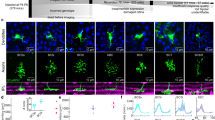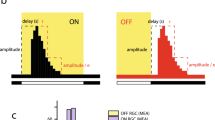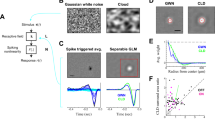Abstract
WHEN light is flashed on the retina, a spatial and temporal pattern of neural activity is produced among several types of retinal cells. The resulting pattern of extracellular voltage can be recorded by placing a microelectrode at various depths within the retina. Recently, most of the graded slow potentials recorded in this way have been identified with components of the intraretinal electroretinogram1–3. In this communication, I conclude that there is another major type of local extracellular slow potential in the frog retina. This potential, referred to here as the proximal negative response (PNR), is most clearly evident in the proximal (anterior) part of the retina4,5. In the past, it has been suggested that the PNR and the electroretinogram (ERG) are fundamentally different in nature4–6. It has never been clearly shown, however, that the PNR can be distinguished from the local, negative intraretinal b wave of the ERG. An alternative hypothesis3,7 that the PNR may simply be the local b wave therefore seems tenable and apparently prevails at present.
This is a preview of subscription content, access via your institution
Access options
Subscribe to this journal
Receive 51 print issues and online access
$199.00 per year
only $3.90 per issue
Buy this article
- Purchase on Springer Link
- Instant access to full article PDF
Prices may be subject to local taxes which are calculated during checkout
Similar content being viewed by others
References
Tomita, T. J., Opt. Soc. Amer., 53, 49 (1963).
Brown, K. T., Vision Res., 8, 633 (1968).
Granit, R., in The Eye (edit. by Davson, H.), 2, chap. 23 (Academic Press, New York, 1962).
Tomita, T., and Torihama, Y., Jap. J. Physiol., 6, 118 (1956).
Gouras, P., Amer. J. Ophthal., 46 (part 2), 59 (1958).
Brindley, G. S., J. Physiol., 134, 360 (1956); Physiology of the Retina and Visual Pathway (Edward Arnold, London, 1960).
Tomita, T., Murakami, M., and Hashimoto, Y., J. Gen. Physiol., 43, (6), part 2, 81 (1960).
Wolbarsht, M. L., MacNichol, jun., E. F., and Wagner, H. G., Science, 132, 1309 (1960).
Murakami, M., and Kaneko, A., Vision Res., 6, 627 (1966).
Byzov, A. L., Cold Spring Harbor Symp. Quant. Biol., 30, 547 (1965).
Author information
Authors and Affiliations
Rights and permissions
About this article
Cite this article
BURKHARDT, D. Distinction between a Proximal Negative Response and the Local b Wave in the Retina. Nature 221, 879–880 (1969). https://doi.org/10.1038/221879a0
Received:
Revised:
Issue Date:
DOI: https://doi.org/10.1038/221879a0
Comments
By submitting a comment you agree to abide by our Terms and Community Guidelines. If you find something abusive or that does not comply with our terms or guidelines please flag it as inappropriate.



